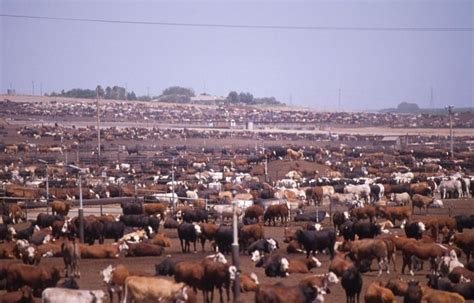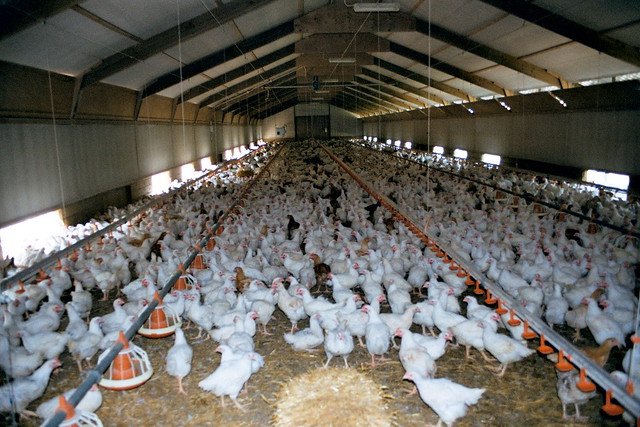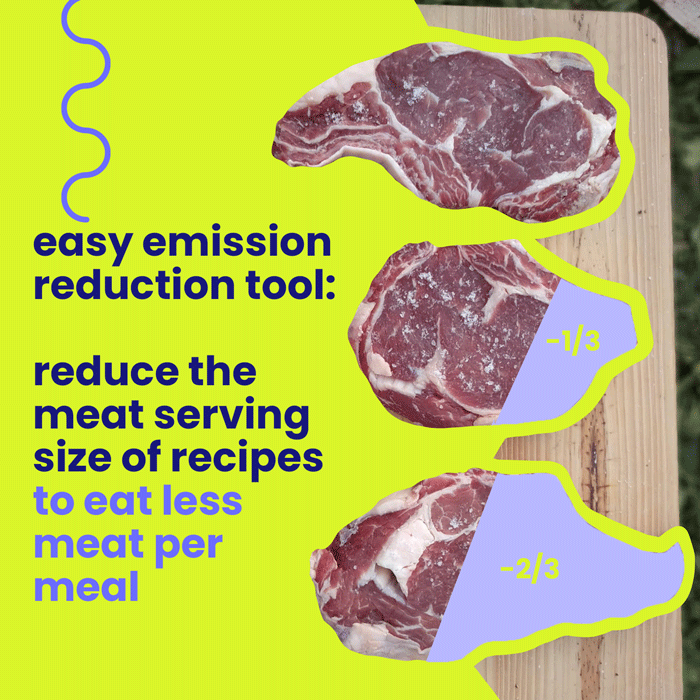Impact of Meat
The Footprint of Meat
Beef, lamb, pork, and poultry are the types of meat sources that exhaust the most land, water, and resources globally, generating a massive amount of emissions and waste. Did you know: The digestive process of ruminants cause the animals to burp methane, a greenhouse gas 28-34 times more powerful than CO2?!
The bigger the animal the bigger the footprint. Beef is the biggest impact with lamb following shortly behind, then pork comes in a little ways down with poultry right behind it. So that means, eating smaller amounts of the larger animals (like beef) makes a very large difference in emissions. For example, poultry produces the lowest amounts of methane, for every 1lb of Methane(CH4) produced by Poultry, swine produces 20lbs CH4, and cattle 524lbs CH4.
Interconnected Impact of Eating Meat:
Methane: What goes in must come out. Burps, farts, manure = emissions
Effluent Waste: Harmful chemicals, antibiotics, pesticides, and too much poo in water runoff = pollution
Land Used & Disrupted: In 2019, the USDA reported the butchery of 2.94 million cows just in May. Every pound of beef requires up to 25 pounds of corn feed. Broken down, we’re looking at millions of acres of land needed to grow corn i.e., food to feed our food = disrupting the natural carbon and soil cycles that land beautifully regenerates.
Shortened Lives: Industrialized agriculture ends the animal’s life once they have reached what they consider full-size. As for their purposes, there’s no reason to keep the animal alive for any longer than what will allow for the maximum return on investment.
Moment of perspective: Most countries do not have the number of resources that the US exhausts to support our beefy appetite! The scale of modern industrialized farming is unsustainable. It’s time for a change.
The Moderation of Meat Consumption
How many times a week do you currently eat beef? What about pork? Lamb? Poultry? Eggs? Do you think you overeat or undereat these sustenances?
Facts:
Less Meat = Less Impact. Switching to smaller animal meats makes a difference too. The greenhouse gas emissions per kilogram of beef are 7.2 times greater than chicken. Eggs are less emissions-intensive than beef, but more so than veggies. One serving of eggs emits 0.89 pounds of CO2e, that’s roughly 325 pounds CO2e per year if you eat an egg a day. Compare that to the 6.6 pounds of CO2e per serving of beef (almost 7x as much as an egg) and we’re looking at a massive reduction in your personal emissions. Eggs-cellent protein alternative!
Americans have the highest meat consumption in the world. This might sound a little repetitive but we’re really trying to illustrate here just how much Americans over-eat beef today.
Switching to a vegetarian meals day ONLY one time per week would save the equivalent emissions of driving 1,160 miles in your car. Think driving from L.A. to Denver (approx).
The silver lining: you don’t have to go full vegetarian or hardcore vegan to make your diet significantly more sustainable! Moderation moves the marker!
The Quality of Meat
How often do you currently check meat labels to determine the quality of the meat products you buy? Always? Sometimes? Never? Is your meat ethically sourced?
Animal welfare is a major concern when it comes to meat. Happy Animals = Happier Eats. Factory Farming is notorious for their cruel, often torturous methods in preparing animals for sale.
Food labels are a way to know whether or not you are buying ethically sourced animal products. Next time you’re in the butcher section, check out the food labels.
Food labels can be tricky however due to good ol’ American marketing, clever marketers have not made your shopping experience any easier. Food labels are often vague. And marketing and industry terminology can be misleading or confusing when trying to identify if something is actually certified or slyly worded to trick you into thinking that it is.
Advocacy groups and the United States Department of Agriculture (USDA) have worked diligently to build nationally recognized certificates of quality that would ensure shoppers know if the meat they’re purchasing is ethically sourced. In a perfect world, you should know exactly where your animal products come from, trusting that the farmer is transparent. But in the U.S., our loose food label guidelines give clever marketers the flexibility to use language that makes a product seem like it was certified by the USDA or ethically sourced. Unfortunately, a growing percentage of these food labels are purposely misleading. Enter greenwashing.
The good certifications and labels to look for:
And what they actually mean...
Certified Organic
Animal products with this label are only fed organic grass or grain without mysterious byproducts, antibiotics, or hormones. The animal’s welfare is typically good. Organic producers must allow animals to graze outside for at least 120 days a year on pastures that meet USDA requirements—meaning the farmer can’t call a 3x3ft yard a “pasture”. The living conditions must “accommodate the health and natural behavior of animals.” This means these animals get the romanticized farm treatment that we think of when we imagine, “home on the range” including shade, shelter, an exercise area, fresh air, clean drinking water, direct sunlight, clean and dry bedding, and a suitable temperature—imagine that. Better yet, these conditions are enforced by on-site inspections.
100% Grass-fed & grass-finished only applies to cows.
According to USDA, once animals have been weaned off milk, they must be fed only grass and what they forage, such as legumes and hay.
Steroid, Hormone and Antibiotic FREE
To ensure that the policy is observed, these animals are tested at random pre or post-slaughter. Hormones occur, naturally, so the “free” on the label means animals weren’t given additional hormones. Keep in mind that even animals who are given antibiotics to prevent disease can receive this designation if the meds aren’t indicated on the test.
Free-Range or Free-Roaming only applies to chickens.
It regulates that “Producers must demonstrate to the Agency that the poultry has been allowed access to the outside” —still, it’s a little vague.
Certified Humane (not to be confused with American Humane Certified)
An animal welfare rating program for most processed meat that sets standards for humane farming. Not to be confused with American Humane—see funny business below.
Natural (not to be confused with Naturally-raised)
The USDA states that the term “natural” must refer to food that is minimally processed with no artificial ingredients. These product labels must include a statement explaining the meaning of the term on the packaging. To make this claim, producers must have supporting documents but the USDA doesn’t verify conduct with on-site inspections. (unless the product also carries an official USDA organic label).
Funny business with these ones:
There’s some funny business with these next ones. We recommend avoiding them.
American Humane Certified
Not recommended by animal advocates.
Cage-free
Only requires each bird to be given 1 to 1.5 square feet of floor space, as well as “environmental enrichments” like perches and nests. Hens raised in cage-free facilities are likely not given access to the outdoors, but studies do show that welfare is generally higher than standard “battery cage” facilities, where birds are kept in tiny cages, restricting them from movement or even spreading their wings.
Naturally-raised
Is in no way defined by the USDA or the FDA, rendering it meaningless.
Pasture-raised
There is no legal definition of “pasture-raised.”











